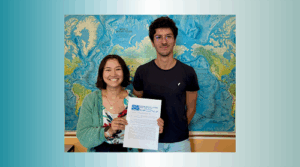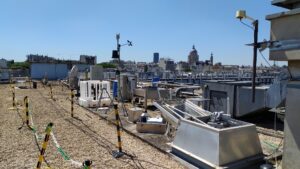Soutenance de thèse
Jonas Hamperl
LATMOS
Development of a differential absorption lidar for remote sensing of water vapor and the isotopologue HDO
Résumé
Observations of stable water isotopologues in the atmosphere provide valuable insights into the condensation and evaporation history of water vapor. The provision of such data with sufficient vertical resolution in the lower troposphere (0–3 km) helps to improve our understanding of basic processes like cloud formation, moist convection and mixing, and offers the potential to increase the accuracy in the predictions made by atmospheric general circulation models. Despite the progress in remote sensing from the ground and from space, retrievals from passive sensors are prone to biases and lack the vertical resolution required for water cycle studies in the lower troposphere.
The aim of this thesis is to investigate an active remote sensing approach based on the differential absorption lidar (DIAL) method to measure both the water vapor main isotopologue H216O and the semi-heavy water isotopologue HD16O with high vertical and temporal resolution (100–200 m, 10 min). The
expected performance of such an instrument in terms of random and systematic errors was first analyzed
using simulations accounting for instrumental and atmospheric parameters. The theoretical analysis showed
that the spectral range around 1.98 μm is suitable for DIAL profiling of H216O and HD16O and that range-resolved measurements require a tunable laser in that wavelength range with pulse energies of tens of mJ.
To fulfill this requirement, a parametric laser source based on a nested-cavity optical parametric oscillator and an optical parametric amplification stage using state-of-the-art high-aperture (5×7mm2) periodically poled potassium titanyl phosphate (PPKTP) crystals was implemented. It delivers widely tunable (1.95–2.30 μm) single-frequency radiation with energies up to 9 mJ for 12 ns pulses at a repetition rate of 150Hz.
Using the developed laser source, DIAL measurements of H216O and HD16O in the atmospheric boundary layer were conducted in direct-detection mode in the frame of several measurement campaigns. It was show that with the developed lidar setup, isotopologue measurements with meaningful precision are limited to the first few hundred meters above the ground. To achieve measurements with range resolution and precision suitable for water cycle studies within the entire boundary layer, further instrumental improvements in terms of laser energy and reduced detection noise are necessary. For this purpose, a further step is proposed for the design and pre-development of a lidar setup capable of achieving a higher sensitivity thanks to an optimized double-stage amplification scheme for the laser transmitter that should allow to reach output energies > 40 mJ.
Informations supplémentaires
–
Composition du jury
Patrick Rairoux Rapporteur – Professeur, Université Lyon 1
Patricia Segonds Rapporteure – Professeure, Université Grenoble Alpes
François Ravetta Examinateur – Professeur, Sorbonne Université (LATMOS)
Caroline Bes Examinatrice – Responsable du service sondage de l’atmosphère, CNES
Jean-Baptiste Dherbecourt Encadrant – Ingénieur de recherche, ONERA
Cyrille Flamant Directeur de thèse – Directeur de recherche, CNRS (LATMOS)






